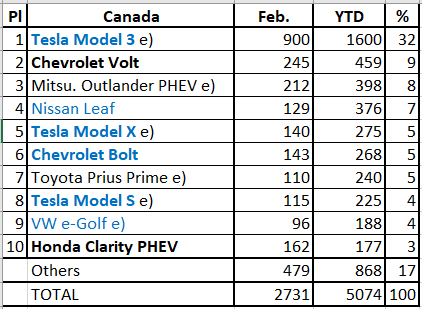EV Sales In Canada: A Three-Year Decline

Table of Contents
Economic Factors Impacting EV Sales in Canada
Rising inflation, increased interest rates, and the overall high cost of living have significantly impacted consumer spending, including discretionary purchases like electric vehicles. The relatively high initial purchase price of EVs, even with government incentives, presents a substantial barrier for many potential buyers. The affordability of EVs is a key factor influencing Canadian EV adoption rates.
-
Increased interest rates make financing EVs more expensive. Higher interest rates increase the monthly payments on EV loans, making them less attractive to potential buyers. This is particularly impactful given the generally higher price point of EVs compared to gasoline-powered vehicles.
-
Inflation erodes purchasing power, making EVs less affordable. The rising cost of living means consumers have less disposable income available for large purchases such as electric vehicles. This makes even those with government incentives reconsider their purchase.
-
High initial cost of EVs remains a significant hurdle. Despite government subsidies and rebates, the upfront cost of EVs often remains substantially higher than comparable gasoline-powered vehicles. This price difference acts as a significant barrier for many Canadian consumers.
-
Reduced government subsidies in some provinces might have played a role. While federal incentives exist, variations in provincial programs and potential reductions in support have contributed to the overall complexity and reduced attractiveness of EV ownership for some Canadians.
Range Anxiety and Charging Infrastructure Gaps
Range anxiety – the fear of running out of battery power before reaching a charging station – continues to be a major deterrent for many Canadians. Insufficient charging infrastructure, particularly outside urban centers, exacerbates this issue. The lack of widespread, reliable, and fast-charging networks hinders long-distance travel for EV owners, making it a less attractive option for many.
-
Limited availability of public charging stations, especially in rural areas. The uneven distribution of charging stations across Canada, with a concentration in urban areas, leaves many rural communities underserved, hindering wider adoption of electric vehicles.
-
Long charging times for some EV models. While charging technology is improving, some EV models still require significantly longer charging times than filling a gasoline tank, creating inconvenience for drivers.
-
Inconsistent charging standards across different charging networks. The lack of standardization in charging connectors and payment systems can create confusion and frustration for EV drivers, impacting their charging experience.
-
Lack of awareness about available charging infrastructure. Many potential EV buyers are unaware of the existing charging infrastructure or how to access it, which adds to their hesitancy in adopting electric vehicles.
Competition from ICE Vehicles and Alternative Fuel Vehicles
The continued popularity of internal combustion engine (ICE) vehicles and the increasing availability of hybrid vehicles offer strong competition to EVs. Attractive financing options and lower upfront costs for ICE and hybrid vehicles make them more appealing to budget-conscious consumers. Furthermore, the rise of alternative fuel vehicles, like those using hydrogen fuel cells, is also diverting some attention from the EV market.
-
Lower upfront cost of ICE and hybrid vehicles. The significantly lower purchase price of ICE and hybrid vehicles compared to EVs remains a major factor driving consumer choices.
-
More readily available fuel infrastructure for ICE vehicles. The extensive network of gas stations across Canada provides readily available fuel for ICE vehicles, unlike the still-developing EV charging infrastructure.
-
Attractive financing deals for gasoline and hybrid vehicles. Competitive financing options for gasoline and hybrid vehicles often outweigh the incentives offered for EVs, making them more accessible to many consumers.
-
Growing competition from alternative fuel vehicle technologies. The emergence of alternative fuel technologies, such as hydrogen fuel cells, presents further competition to the EV market, potentially diverting investment and consumer interest.
Government Policies and Incentives – Their Impact
Government policies and incentives play a crucial role in shaping EV adoption. Changes in government support, either reductions or shifts in focus, can directly influence consumer behaviour and market trends. A clear, consistent, and long-term strategy is essential to stimulate EV sales. Inconsistency or uncertainty in government support can lead to market hesitancy.
Conclusion
The three-year decline in EV sales in Canada is a complex issue stemming from a confluence of economic factors, infrastructure limitations, and competition from alternative vehicle types. Addressing range anxiety through expanded charging infrastructure, mitigating the high cost of EVs through sustained government incentives and innovative financing options, and fostering a clear policy framework for sustainable transportation are crucial steps to revive the Canadian EV market. Understanding the reasons behind this decline is essential for developing effective strategies to boost EV sales in Canada and achieve the country's ambitious climate goals. Continued monitoring of EV sales in Canada and adapting policies accordingly will be key to fostering growth in this vital sector. Let's work together to increase EV sales in Canada and build a sustainable transportation future.

Featured Posts
-
 Canadas Tourism Surge A Look At The Numbers
Apr 27, 2025
Canadas Tourism Surge A Look At The Numbers
Apr 27, 2025 -
 Pegula Defeats Collins To Win Charleston Title
Apr 27, 2025
Pegula Defeats Collins To Win Charleston Title
Apr 27, 2025 -
 The Dax Index A Comprehensive Look At Political And Economic Drivers
Apr 27, 2025
The Dax Index A Comprehensive Look At Political And Economic Drivers
Apr 27, 2025 -
 Sorpresivas Derrotas Para Paolini Y Pegula En El Wta 1000 De Dubai
Apr 27, 2025
Sorpresivas Derrotas Para Paolini Y Pegula En El Wta 1000 De Dubai
Apr 27, 2025 -
 Premier Leagues Fifth Champions League Spot Almost Certain
Apr 27, 2025
Premier Leagues Fifth Champions League Spot Almost Certain
Apr 27, 2025
Latest Posts
-
 Ray Epps Sues Fox News For Defamation January 6th Allegations At The Center Of The Case
Apr 28, 2025
Ray Epps Sues Fox News For Defamation January 6th Allegations At The Center Of The Case
Apr 28, 2025 -
 Open Ai Facing Ftc Probe Concerns Regarding Chat Gpts Data Practices
Apr 28, 2025
Open Ai Facing Ftc Probe Concerns Regarding Chat Gpts Data Practices
Apr 28, 2025 -
 Cassidy Hutchinsons Upcoming Memoir Details January 6th Testimony
Apr 28, 2025
Cassidy Hutchinsons Upcoming Memoir Details January 6th Testimony
Apr 28, 2025 -
 Cassidy Hutchinson Key Witness To Publish Memoir On January 6th Hearings
Apr 28, 2025
Cassidy Hutchinson Key Witness To Publish Memoir On January 6th Hearings
Apr 28, 2025 -
 Hollywood Production Halted Writers And Actors Strikes Combine
Apr 28, 2025
Hollywood Production Halted Writers And Actors Strikes Combine
Apr 28, 2025
